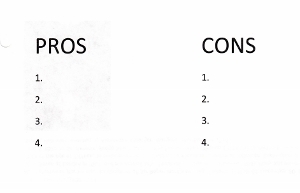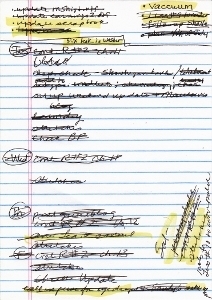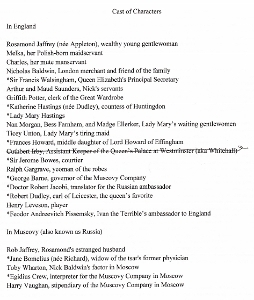The Power of Lists
 I make lists. I can’t remember when I didn’t. I do remember my father telling me when I was quite young that the best way to make a hard decision is to make a list of pros and cons and look at which one is longer.
I make lists. I can’t remember when I didn’t. I do remember my father telling me when I was quite young that the best way to make a hard decision is to make a list of pros and cons and look at which one is longer.
I share this list-making habit with a great many many fictional sleuths, including the four female detectives I have created over the years. Liss MacCrimmon, the contemporary sleuth I write about as Kaitlyn Dunnett, makes more lists than I do. In the mysteries I write as Kathy Lynn Emerson, all three of my historical detectives, from Susanna, Lady Appleton, in the Face Down series, to Diana Spaulding in my 1888 Quartet, to the soon to be in print Rosamond Jaffrey, use lists to help them solve crimes.
As a reader, I relate to fictional sleuths who make lists. One of my favorites is Elizabeth Peters’ Amelia Peabody Emerson (no relation). In The Curse of the Pharaohs, she decides to “make a little chart, setting forth the various motives and means and so on.” By Deeds of the Disturber, she remarks that her brain “works too swiftly to be easily organized,” but she falls back on list making anyway, making one that consists of two columns, “QUESTIONS” and “WHAT TO DO ABOUT THEM.” She comes up with nine entries, ranging from “Were the splashes of dark liquid human blood?” (“Inquire of Inspector Cuff.”) to “Who is the lunatic in the leopard skin?” (“Catch the scoundrel in the act.”). In the end, this list does not prove particularly useful, but it does illustrate the way the character’s mind works and provides both a quick review of what she knows about the case to that point and a bit of comic relief.
 In real life, I rely on lists. Some serve as powerful motivators. Others just help me keep track of things. The 5×7 lined tablet beside my computer is my primary personal to-do list. There can be a real sense of satisfaction in crossing off a completed task. I don’t really need to write “cont. R#2″ to remember to spend time on the next bit of my current work in progress (the second Rosamond Jaffrey mystery), but I do like running a line through that notation when I finish my pages for the day. Ditto for “ans. email” and “stretches.” That last refers to the hour or so I spend, six days out of seven, doing an assortment of stretches to relieve arthritis pain. It includes a stint on the stationary bike that doubles as reading time.
In real life, I rely on lists. Some serve as powerful motivators. Others just help me keep track of things. The 5×7 lined tablet beside my computer is my primary personal to-do list. There can be a real sense of satisfaction in crossing off a completed task. I don’t really need to write “cont. R#2″ to remember to spend time on the next bit of my current work in progress (the second Rosamond Jaffrey mystery), but I do like running a line through that notation when I finish my pages for the day. Ditto for “ans. email” and “stretches.” That last refers to the hour or so I spend, six days out of seven, doing an assortment of stretches to relieve arthritis pain. It includes a stint on the stationary bike that doubles as reading time.
This list, broken down by day of the week, has a sub-list going on the same page. Those are items I really need to do sometime soon, but which will be squeezed into spare moments in between the items on the main list. Some of these, like VACUUM and DUST, may end up being moved along from page to page without much hope of being crossed off until the dust bunnies are bigger than our cats . . . and we have BIG cats. Still, putting an item anywhere on the page means I see it every time I look at the list. Eventually, all the items gets crossed off, even the housework.
 When I’m working on a mystery novel, two other lists are essential. One is a list of characters, with sub lists of suspects and motives much like the ones my sleuth will eventually be making. Initially, though, the purpose of the character list is to work out their names. Listing all the characters highlights quite a few potential problems right at the start of the project. Are there too many characters whose names start with the same letter? Have I given a character a name that doesn’t fit his or her personality (unless that’s the point)? From the character list, I make individual character sheets and keep them in alphabetical order, then rearrange my character list “in order of appearance.” Somewhere along the way, I give every suspect a secret. This secret may or may not come out in the course of the investigation, but it helps me get a handle on what that person is like.
When I’m working on a mystery novel, two other lists are essential. One is a list of characters, with sub lists of suspects and motives much like the ones my sleuth will eventually be making. Initially, though, the purpose of the character list is to work out their names. Listing all the characters highlights quite a few potential problems right at the start of the project. Are there too many characters whose names start with the same letter? Have I given a character a name that doesn’t fit his or her personality (unless that’s the point)? From the character list, I make individual character sheets and keep them in alphabetical order, then rearrange my character list “in order of appearance.” Somewhere along the way, I give every suspect a secret. This secret may or may not come out in the course of the investigation, but it helps me get a handle on what that person is like.
The other list that is a must when I write a mystery is one I call “who knows what when?” Creating this list avoids all sorts of continuity problems, but it can’t be compiled until a good chunk of the writing has already been done. At that point, I read through what I have written and make notes. If I’ve developed a really complicated plot, the list sometimes expands into a chart. Looking at it helps me tie up all the loose ends, too. And sometimes it points up things that I can change to make the story work even better.
So that’s my take on the power of lists. How about you folks reading this post? Do you make lists? Or have a favorite list-making detective? Or (bonus question!), have you ever seen the classic mystery movie, The List of Adrian Messenger? Leave an answer or comment to be entered in a drawing for an advance reading copy of the next Liss MacCrimmon mystery, Ho-Ho-Homicide. Cut-off date is the 4th of July. The winner’s name will be announced in the July 5-6 Weekend Update.
Lea Wait's Blog
- Lea Wait's profile
- 506 followers



